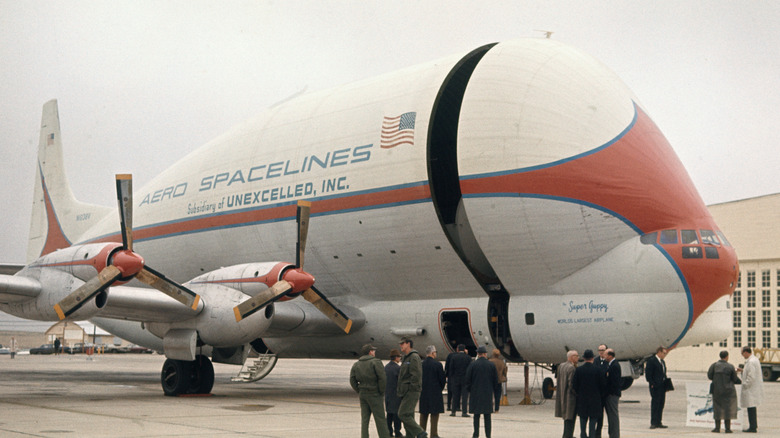This 500-Foot-Wingspan Plane Might Be Boeing's Wildest Design Of All Time
The early 2000s saw the rise of our digital era. We had cell phones, but no smart phones, and Apple introduced the original iPod. Blockbuster still existed, though many of us were renting Netflix DVDs through the mail. Social Media consisted of MySpace and Friendster. The attacks on September 11, 2001, sparked the war on terror. And Boeing designed a cargo plane that, had it actually been made, would have been the largest in aviation history.
Dubbed the Pelican Super Transport, it was Boeing's response to the U.S. Department of Defense's request for a plane that could rapidly deploy to a conflict zone. It was designed by Phantom Works, Boeing Defense, Space & Security's advanced research, development, and prototyping division, and if it had come to fruition, could have moved 3,000 troops and seven-and-a-half thousand tons of equipment into a war zone within 96 hours. The design was also, in one word, massive.
The Pelican design had a wingspan of 500 feet and weighed 1,600 tons. By comparison, the plane with the largest wingspan currently flying is Scaled Composites' Model 351 Stratolaunch, which has a wingspan more than 100 feet smaller, at 385 feet. It could have carried almost 200 cargo containers stacked two-high, including 20 in each wing, or an entire minefield's worth of land mines. If the military had to shift equipment, they could have moved 17 M1 Abrams tanks or 70 heavy expanded-mobility tactical trucks with the Pelican. Why then did the Pelican join the ranks of other failed Boeing designs, like the double-decker 747X and the supersonic 2707? It was simply too big.
The Pelican's unique design
In nature, the pelican is a sizable and oddly graceful bird. While we'll never see the Pelican Super Transport in the air, its design does somehow bring to mind these rather awkward-looking creatures. Plans called for a nose-loading freighter, with a hinged nose that would swing open to load large freight, similar to the famous Guppy plane.
To get the Pelican off the ground, Boeing designed eight 80,000-horsepower turbine engines, taking it 20,000 feet at 300 mph. Most military and cargo planes fly much higher, but the Pelican would have spent most of its time much closer to the ground. The massive aircraft would have relied on ground effect, wherein a plane gains additional lift and experiences reduced drag when flying no higher than the length of its wingspan above the surface.
The Boeing 747 has 18 tires, while the C-5 Galaxy has 28. To safely land, the Pelican would have needed a whopping 76 wheels, arranged in two long rows along its fuselage. Each wheel would have been steerable to help the plane battle crosswinds, but they also would have made takeoff challenging. With that many wheels, it would not have been able to lift off from the ground like your typical commercial airliner, but likely would have required a vertical takeoff.
Why the Pelican never took flight
The Boeing Pelican may seem ambitious on paper, but the aviation world has seen more absurd designs. Like, for example, Howard Hughes' H-4 Hercules, nicknamed the Spruce Goose because it was actually built using a composite of birchwood and resin. While the Pelican's massive size was indispensable to the government, it was also its Achilles' heel. Having to cruise at such a low altitude opened up the aircraft to a host of issues on long flights, including bird strikes and even impacts from waves when crossing oceans. Additionally, despite its name, the Pelican would not have been able to land on water.
The aircraft would have had limited maneuverability as well, both on the ground and in the air. Fully loaded, the plane could have weighed up to 3,000 tons, or more than six million pounds. It would have been too heavy for most runways, capable of destroying asphalt. It also would have been very expensive. In 2005, the U.S. Congress concluded that Boeing would likely be unable to deliver the Pelican by its 2015 target date, and the Department of Defense cited potential issues with deploying such an aircraft. By 2006, Boeing shelved the project, and the Pelican was left to the annals of unrealized aviation history.


